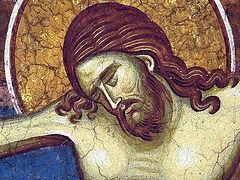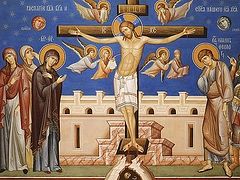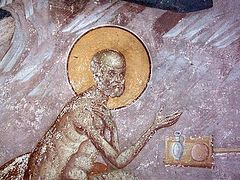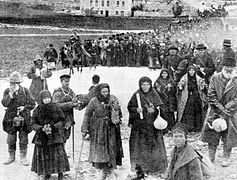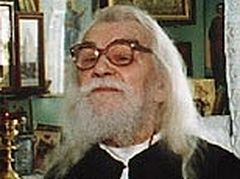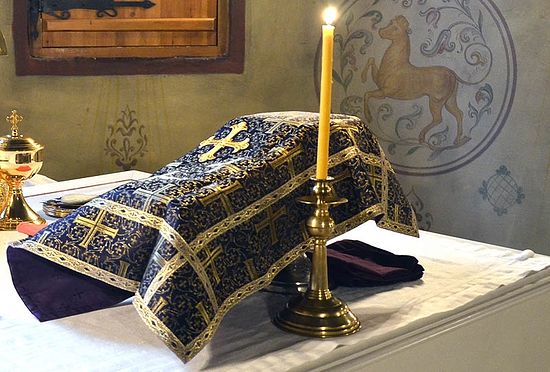 Photo: Pravoslavie.ru
Photo: Pravoslavie.ru
The forty-day lent has ended. The sounds or grief for our sins have fallen silent in order to give way to another grief—the memory of the salutary sufferings of the God-man for us sinners. The Church does not omit one moment of the consecutive development of the holy events of the last days of the Lord’s earthly life. It leads us in His steps from Bethany (the place where Lazarus was raised) to Jerusalem, then to the Mount of Olives, to the Sion chamber (where the Last Supper took place), to Gethsemane, to the court of the high priest and into the Praetorium of Pilate, to the Place of Skulls (Golgotha), and, finally, to the burial cave of the righteous Joseph of Arimathea.
The first three days of Passion Week the deeds of the Savior are revealed to the mental gaze of those praying, His discussions, parables and teachings which occurred between the entrance of the Lord into Jerusalem and the Last Supper. The Church sees to it that the praying feel all the salutary sufferings of Christ and His endless compassion for people.
The services of these three days consist of Matins, Hours and Vespers, in conjunction with the Liturgy of the Presanctified Gifts. At the beginning of Matins the following troparion is sung, the basis for which is the parable of the Nine Virgins (Matthew 25:1-13):
Behold, the Bridegroom cometh in the middle of the night, and blessed is that servant whom He shall find watching; and again unworthy is he whom He shall find heedless. Beware, therefore, O my soul, lest thou be borne down with sleep, lest thou be given up to death, and be shut out from the Kingdom. But rather rouse thyself and cry: Holy, Holy, Holy art Thou, O God, through the Theotokos, have mercy on us.
After the canon the exapostilarion is sung, which is based on the parable of the bridal feast (Matthew 22:1-14).
Thy bridal chamber, O my Savior, do I behold all adorned, and a garment I have not that I may enter therein. Illumine the garment of my soul, O Light Bestower, and save me.
Great Monday
On this day the Church invites all believers to accompany Christ, in a sense to die with Him in regards to earthly pleasures, in order to be resurrected with Him in spirit. By bringing together the events of the Old and New Testaments, the Church shows the believers the Savior’s sufferings in the Old Testament exemplar of the righteous Joseph, innocently sold and belittled due to the jealousy of brothers, but later restored by God to great glory (Genesis, chapters 37-41). The Gospel readings on this day are the tale of the barren fig-tree and the parable of the evil husbandmen. The barren fig tree, cursed by the Lord, portrays the Jewish nation which only looked righteous, but was dried up internally and unspiritual. The evil husbandmen portray the Judaic leaders, who only use the property of God only for their benefit and destroying the prophets He sends (Matt. 21:18-43; Matt. 21:3-35).
On Great Tuesday the Gospel readings present the discussions of the Savior about the resurrection of the dead and of His second coming, the parable of the ten virgins, the parable of the talents and about the Last Judgment (Matt. 22:15; 23:39; Matt. 24:36; 26:2).
Great Wednesday
The Lord spent the night before Wednesday in Bethany (Matt. 26:6-17). Here, in the house of Simon the leper, a woman poured expensive spikenard on the head of the Savior and thus prepared Him for burial. In the church prayers this woman’s unselfish act is contrasted to Judas’ ingratitude, who had thought to betray Christ to the Judaic leaders for money. The morning Gospel presents the prediction of the Savior of His impending death on the cross and of the founding of the Church among the heathen (John 12:17-50). The Liturgy of the Presanctified Gifts is served for the last time on Great Wednesday, and the penitent prayer of St. Ephraim of Syria "O Lord and Master of my life…" is also read for the last time.
Great Thursday
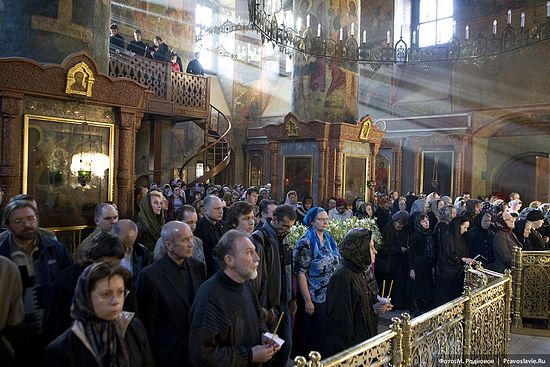 Sretensky monastery. Photo: M.Rodionov / Pravoslavie.Ru
Sretensky monastery. Photo: M.Rodionov / Pravoslavie.Ru
The prayers of Great Thursday are full of deep feelings and thoughts in connection with the series of Gospel events of the day. They contain admiration for the meekness of the Savior, expressed in the washing of the feet of his disciples; reverence for the mystery of the Body and Blood of Christ; glorifying the endless selflessness of Christ; grief over His sufferings; indignation at the hardness of the Jews and the perfidy of Judas.
At the beginning of Matins (which is served on Wednesday evening) the troparion is sung about how Judas, blinded by greed, leaves the Last Supper.
When the glorious disciples were enlightened at the washing of the feet, then Judas the ungodly one was stricken and darkened with the love of silver. And unto the lawless judges did he deliver Thee, the righteous Judge. O thou lover of money, behold thou him that for the sake thereof did hang himself, flee from that insatiable soul that dared such things against the Master. O Thou Who art good unto all, Lord, glory be to Thee.
The Matins canon, beginning with the words "Verily, the Red Sea was cleft by the rod" explains the meaning of the Last Supper is and portrays the spiritual union of the Lord Jesus Christ and His disciples.
On Thursday morning the Liturgy of Basil the Great is performed, preceded by Vespers. The Gospel reading tells of the Last Supper, the washing of feet and the prayer in Gethsemane. In place of the Cherubic Hymn is sung:
Of Thy Mystic Supper, O Son of God, receive me today as a communicant; for I will not speak of the Mystery to Thine enemies; nor will I give Thee a kiss as did Judas; but like the thief do I confess Thee: Remember me, O Lord, when Thou comest in Thy Kingdom.
Instead of "It is truly meet" the ninth irmos of the canon is sung:
Come, ye believers, let us enjoy the banquet of the Lord, an immortal table, in the upper chamber, receiving with uplifted minds exalted words (ours) from the Word (God) whom we magnify.
On this day, when the Savior established the mystery of Communion and gave communion to the apostles with His own hands, it is necessary to approach the Chalice with special trepidation, pondering the greatness of Christ’s love and one’s own worthlessness.
The Service of the Twelve Gospels
The Matins of Holy and Great Friday are performed on the evening of Great Thursday, or, as it is generally referred to, the Service of the Twelve Gospels. All of this service is dedicated to the reverent memory of the salutary sufferings and death of the God-person on the cross. Every hour of this day has a new act of the Savior, and the echoes of these acts are heard in every word of the service. In it, the Church reveals the full picture of the sufferings of the Lord before the faithful, beginning with the bloody perspiration in the garden of Gethsemane to the crucifixion on Golgotha. Carrying us back in thought through the past centuries, the Church in essence leads us to the very foot of Christ’s cross and makes us trembling viewers of all of the Savior’s sufferings. The faithful hear the Gospel readings with lit candles in their hands, and after each reading thank the Lord through the lips of the choir with the words: "Glory to Thy forbearance, O Lord, glory to Thee." After each reading of the Gospel, the bell is rung the appropriate number of times.
The Passion Gospels:
-
John 13:31-18:1 (The farewell discussion of the Savior with His disciples and His prayer at the Last Supper).
-
John 18:1-28 (The taking of the Savior under guard in the garden of Gethsemane and His sufferings at the high priest Annas).
-
Matthew 26:57-75 (The sufferings of Christ at the high priest Caiaphas’ and the denial of Peter).
-
John 18:28-40, 19:1-16 (The sufferings of Christ at the trial of Pilate).
-
Matthew 27:3-32 (The despair of Judas, the new sufferings of the Lord at Pilate’s and the verdict of crucifixion).
-
Mark 15:16-32 (The path of the Lord to Golgotha and His sufferings on the cross).
-
Matthew 27:34-53 (About the sufferings of the Lord on the cross; miraculous signs, accompanying His death).
-
Luke 23:23-49 (The Savior’s prayer for His enemies and the repentance of the wise robber).
-
John 19:25-37 (The words of the Savior from the cross to the Theotokos and to the Apostle John, His death and the piercing of His rib).
-
Mark 15:43-47 (The taking of the body of the Lord from the Cross).
-
John 19:38-42) (Nicodemus and Joseph bury Christ).
-
Matthew 27:62-66 (The placing of the guard at the tomb of the Savior).
During the intervals between Gospels antiphons are sung which express indignation at the betrayal of Judas, the lawlessness of the Jewish leaders and the spiritual blindness of the mob. "What caused thee, O Judas, to betray the Savior?" it is stated here. "Did he set thee aside from the disciples? Did He deny thee the gift of healing? Did he take supper with the others and send thee away from the table? Did He wash the feet of the rest and pass thee by? Of how much goodness has thou become forgetful?" Then, as if from the person of the Lord, the choir turns to the ancient Jews: “My people, what have I done unto thee; and wherewith have I harmed thee? Thy blind have I lighted; thy lepers have I cleansed, and the man on his couch have I raised. O My people, what have I done unto thee, and wherewith hast thou rewarded Me? Instead of manna, gall; and in place of water, vinegar; and instead of loving Me, thou didst nail Me to the Cross. I can endure no more. I will call the Gentiles, and they shall glorify Me with the Father, and the Spirit. And I will grant them everlasting life."
After the sixth Gospel and the reading of the "Makarizmoi" with troparions comes the canon with three odes, conveying in compressed form the last hours of the Savior with the apostles, the denial of Peter and the sufferings of the Lord, and then the exaposteilarion (svetilen) is sung three times. Here we put down the odes of the canon.
First ode:
Early will I seek Thee, O Word of God, who of Thy compassion didst empty Thyself, being led even unto suffering without trasubstantiation and without suffering, for the sake of the fallen. Wherefore, grant me safety, O Lover of mankind.
Second ode:
The divine youths exposed the God-contending pillar of wickedness; and the assembly of the wicked, roaring at Christ, conspired falsely, studying how to kill Him who holdeth life in his grasp, Whom all creation doth bless, glorifying Me unto all ages.
Third ode:
O Thou who art more honorable than the cherubim, and beyond compare more glorious than the seraphim, who without corruption didst bear the Word of God; truly, Thou art the Theotokos, and Thee do we magnify.
After the canon the choir sings the touching exaposteilarion, in which the repentance of the robber is remembered:
Thou made the thief worthy of paradise on the same day, O Lord. Wherefore, illuminate me too by the tree of Thy Cross and save me.
The stichera from the Einos:
Every member of Thy holy body, O Savior, hath endured humiliation for our sakes; the head with thorns, the face with spitting, the cheeks with blows, the mouth with the taste of vinegar mixed with gall, the ears with blasphemies replete with infidelity, the back with scourges, the hand with the rod, the extension of the whole body with the Cross, the extremities with nails, and the side with the spear.
At the end of the service, before the benediction, the choir sings the troparion: Thou didst ransom us from the curse of the Law (of the Old Testament) by Thy precious Blood. Nailed to the Cross and pierced with the lance, Thou didst pour forth immortality for men. O our Savior, glory be to Thee.
There exists an ancient tradition of not putting out the candle after the last Gospel, but taking it home lit, and with its flame making small crosses on the door jams of all the doors in the house (to protect the home from all evil, Exodus 12:22). The votives before the icons are also lit with this candle.
Holy and Great Friday
On Great Friday, the very day of the death of the Savior, the Liturgy is not served in order to denote extreme sorrow. In its place the Royal Hours are served, which are entirely devoted to the events of this day.
Around three o’clock in the afternoon Vespers are served with the procession of the Shroud (the image of the Savior taken from the cross). At the beginning of Vespers, after the 104th psalm, the stichera on "O Lord, to Thee I have cried" are sung:
The whole creation, O Christ, hath been transfigured by fear at beholding Thee suspended on the Cross. The sun was darkened, the foundations of the earth were troubled, and everything suffered with the Creator of all. Wherefore, O Thou who didst endure this willingly for us, O Lord, glory be to Thee.
During the entrance with the censer the choir sings:
Today is beheld the working of a dread and strange mystery; for He who is inapprehensible is laid hold of; and He who released Adam is chained. He who trieth the hearts and reins is tried falsely; and he who looketh into the depths is locked in prison. He before whom the heavenly powers stand trembling standeth before Pilate. The Creator is smitten by the hand of His creatures; the Judge of the living and the dead is condemned to death on a Tree; and the Destroyer of hades is enfolded in a grave.
Three Old Testament excerpts are read after the entrance. The first relates the appearance of the glory of God to the prophet Moses (Ex. 33:11-23). Moses, praying for the sinful Hebrew nation, served as the image of the universal Intercessor on Golgotha, Jesus Christ. The second reading relates how God blessed Job for his patient bearing of sufferings (Job 42:12-16). Job served as the image of the innocent Godly Sufferer Jesus Christ, returning the blessing of the Heavenly Father to the people. In the third reading the prophecy of Isaiah is presented concerning the redeeming sufferings of the Savior (53:1-12).
The Apostle reading speaks of the Godly Wisdom revealed in the Lord’s Cross (1 Cor. 1:18-2:2). The Gospel reading, consisting of several Gospels, relates in consecutive order the events concerning the crucifixion and the death of the Lord Jesus Christ. Then, after the petitions, the choir sings the Aposticha. During the last stichera, below, the priest thrice censes the Shroud, lying on the altar.
O Thou Who puttest on light like a garment, when Joseph with Nicodemus, took Thee down from the Tree and beheld Thee dead, naked, and unburied, he struck up a compassionate dirge, and with mourning he said: Woe is me, O sweetest Jesus! When but a short while ago the sun beheld Thee hanging upon the Cross, it shrouded itself in darkness, and the earth quaked with fear, and the veil of the Temple was rent asunder. But, behold, now I see Thee willingly submitting to death for my sake. How shall I bury Thee, O my God? Or how shall I wrap Thee with winding sheets? With what hands shall I touch Thine undefiled Body? Or what dirges shall I sing at Thy departure, O Compassionate One? I magnify Thy Passion; I praise Thy Burial and Resurrection, and I cry out: O Lord, glory be to Thee.

After "Now lettest." and "Our Father" the priests and servers proceed with the Shroud from the sanctuary, symbolizing the burial of the Savior. They raise the Shroud from the altar and carry it into the center of the church through the northern door. The altar boys lead with candles, the deacon—with the censer, and the praying meet the Shroud with lit candles in hand. The Shroud is placed on a special "tomb" standing in the center of the church and decorated with white flowers. During this time the choir sings the burial troparion to a special melody:
The noble Joseph, taking Thine immaculate Body down from the Tree, and having wrapped It in pure linen and spices, laid It for burial in a new tomb.
Unto the myrrh-bearing women did the Angel cry out as he stood by the grave: Myrrh is meet for the dead, but Christ hath proved to be a stranger to corruption
After censing the Shroud, everyone kneels and kisses the images of the wounds on the Savior’s body, thanking Him for His endless love and long-suffering. During this time the priest reads the canon "The Tears (Cry) of the Theotokos" The Holy Shroud remains in the middle of the church for three incomplete days, reminding the faithful of the three days’ presence of the body of Christ in the tomb. From this moment the bells are not rung until the beginning of the Easter service, in observance of reverent silence while the Body of Christ rests in the tomb. The Church assigns complete abstention from food this day.
In the evening of the same day the matins service of Holy and Great Saturday is held with the rite of burial of the Savior and the procession of the cross around the church. At the beginning of the service, during the singing of the troparion "Noble Joseph…" the faithful light candles while the clergy leave the sanctuary and go to the Shroud, where they cense the shroud and the entire church. The rite of burial is performed in the center of the church. The choir sings passages from the 119th psalm, while the next reads a troparion priest after each passage. The troparia of the burial rite reveal the spiritual essence of the expiatory feat of the God-person, remember the grief of the Most Holy Theotokos and profess faith in the Savior of humanity. The rite of the singing of the 119th psalm with the funeral troparia is divided into three parts, called "stases." Small petitions are read between the stases.
After the third stasis, prefacing the coming resurrection of the Savior, the choir sings "The Heavenly Host…"—which is sung on all-night services before Sunday.
The choir sings the odes of the canon "The children of those who were saved…" in which is portrayed the horror of all creation at the sight of the Creator in His tomb. This canon is one of the most perfect creations of church-Christian poetry. It is presented in full at the end of this article. The ninth ode "Mourn not for me, Mother…"completes the graveside song.
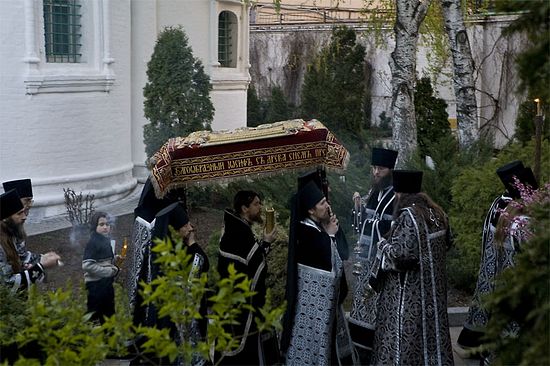
At the end of the Great Doxology, during the singing of "Holy God," the Shroud, accompanied by candlelight, banners, and the censing of incense, is lifted from the tomb and, with slow strikes of a bell, is reverently carried around the church in commemoration of the burial of Jesus Christ. In addition, the descent of Jesus Christ into hell and the victory of Christ over hell and death is also represented: the doors of heaven are opened once again through the Savior’s Sufferings and Death, and the Shroud, after being carried into the church, is brought to the Royal doors. After the priest’s exclamation: "Wisdom, let us attend," the choir sings the troparion "The noble Joseph…" and the Shroud is again laid on the tomb in the center of the church. Old Testament readings, the Apostle and the Gospel are read before the Shroud. The readings consist of the prophetic vision of Ezekiel about the resurrection of the dead bones (Ezek. 37:1-14). The Apostle reading calls upon everyone to keep Pascha "not with old leaven, neither with the leaven of malice and wickedness; but with the unleavened bread of sincerity and truth" (1 Cor. 5:6-8; 3:13-14). The short Gospel relates the placing of the seal on the tomb of the Savior and the ordering of the watch (Matt. 27:62-66).
Holy and Great Saturday
Christ is in the tomb. The disciples, it seemed, buried their hope and faith together with Him. Until the end they did not want to part from their ideas of a glorious earthly kingdom. But Christ not only did not found this kingdom, but He died like a criminal. If even He was powerless, then evil, apparently, is stronger than everything? Sabbath—is the day of rest. In this forced inactivity the horror of that which had occurred became even more clear: "But we trusted that it had been He." How they had rushed to share positions and thrones! The Evangelists keep silent about what the disciples went through and thought on that Easter Saturday. But their very silence speaks more eloquently than any words.
Night descends. The watch slumbers at the sealed tomb. Suddenly an underground blow shakes the hill. The stone crashes away. A flash like lightning throws the soldiers to the earth. The tomb is empty. The watch runs in terror. Christ, who descended into the darkness of the nether world, turned out to be stronger than death.
In antiquity the Liturgy of Great Saturday, like the other Great Lent Liturgies, was performed in the evening, and for this reason it is begun with vespers. Since the evening service always refers to the next day, and the next day is Pascha, the Liturgy of Great Saturday combines two moments: on the one hand, it is a Passion service, on the other—it begins the Easter feast. These opposing features—sorrow and joy, tears and radiant joy—are miraculously combined during the service. The image of the buried Savior still lies in the center of the church, but the choir is already singing His conquest over death.
In the beginning of the service, after the singing of the stichera on "O Lord, to Thee I have cried…" and the small entrance, fifteen Old Testament readings are read before the Shroud. In antiquity the baptism of the catechumens was performed on Great Saturday—persons prepared for accepting Christianity. The lengthy readings allowed enough time to complete the mystery of baptism over many catechumens.
Old Testament Readings: 1) Genesis 1:1-13 (creation). 2) Exodus 60:1-16 (the New Testament Church). 3) Exodus 12:1-11 (the establishment of Passover). 4) Jonah chapters 1-4 (the history of the prophet Jonah). 5) Joshua 5:10-15 (the celebration of Passover in Joshua’s time). 6) Exodus 13:20-14:32 (crossing the Red Sea). At the end of this reading the choir sings a multiple of times "For gloriously is He glorified." 7) Soph. 3:8-15 (calling the heathen to the Church). 8) 3 Kings 17:8-23 (the Prophet Elijah resurrects the youth). 9) Exodus 61:10-11, 62:15 (the New Testament Church). 10) Gen. 22:1-18 (the sacrifice of Isaac). 11) Exodus 61:1-9 (the sermon of the Messiah). 12) 4 Kings 4:8-37 (the prophet Elisias resurrects the youth). 13) Exodus 63:11-64:5 (the repentant prayer). 14) Jeremiah 31:31-34 (the conclusion of the New Testament). 15) Daniel 3:1-51 (the salvation of the three children in the Babylonian furnace). At the end of the readings the choir sings multiple times "O praise ye the Lord and supremely exalt Him unto the ages."
For the newly baptized, standing now in the church in white gowns with candles in hand, the choir instead of "Holy God" now sings "Ye who have been baptized into Christ, have put on Christ" (Gal. 3:27). After this the singing of Vespers changes to the Liturgy.
The Apostolic reading (Rom. 6:3-11) calls on Christians to die with regards to sin in order to live with Jesus Christ. The turning point in the service occurs at this time, the change from the Passion to the Paschal: the Sanctuary doors are shut and all the vestments in the church are changed from dark to white. The choir repeats in triumphant melody many times: "Arise, O Lord, judge the earth, for Thou shalt have an inheritance among all the nations" (Ps. 81:8). Toward the start of the Gospel reading, which announces the resurrection of the Savior (Matt. 28:1-20), the church acquires a bright, Paschal appearance. After the Gospel the Liturgy of Saint Basil the Great continues in its usual order.
Instead of the Cherubic hymn, the choir sings:
Let all mortal flesh keep silence and stand with fear and trembling, and take no thought for any earthly thing, for the King of kings and Lord of lords cometh to be slain and given as food for the faithful. Before Him go the choirs of the angels with all sovereignty and power: the many-eyed Cherubim and six-winged Seraphim, covering their faces and crying out the hymn: Alleluia, Alleluia, Alleluia.
Instead of "It is meet" the choir sings the 9th ode of the matins canon:
Mourn not for me, Mother, as Thou beholdest Me in the grave; for I Thy Son, whom Thou didst conceive in Thy womb without seed, shall rise and shall be glorified. And being God, I will ceaselessly exalt and ennoble those who in faith and longing magnify Thee.
The service of Holy and Great Saturday serves as the transition to the upcoming day, considered the Feast of Feasts—the Resurrection of Christ. For fortification, the faithful are given blessed breads moistened with wine at the end of the service.
Besides a strict fast, the observance of Great Saturday in antiquity was remarkable in its particular inner concentration and festal silence in church life. "What is this?" says St. Epiphany in his discussion on Great Saturday. "Today great silence and peace rule on earth. Deep silence, because the King sleeps. The earth fears and is quiet, because God sleeps in Body and wakens those who have slept from the ages. God died in Body, and the netherworld trembles. God slept for a short time, in order to awaken those who are in netherworld."
Conclusion.
And so, the Passion week is the most momentous time of the year, uplifting the soul of the Christian and disposing it to accepting the most elevated thoughts and impressions—a time, offering much fare for religious Christian thought and heavenly delight for the believing heart. The passion services enjoin the faithful to the blessed fruits of redemption, give them to feel the power of His endless love in His compassion towards humans. St. John Chrysostom thus summarizes the meaning of Christ’s feat on the Cross: The ancient tyranny of the devil is destroyed on the cross, the strong is tied and his weapons taken away, sin is ironed out, death is trampled and the curse is removed from men, the obstacle of separation is removed and Paradise is opened, Heaven has become accessible and people have drawn closer to the angels; God has reconciled the heavenly and the earthly."
Real perception of Christ’s love should help us understand how dear we are to God. This realization will help us perk up, so that we would not be dejected because of life’s different sorrows. There is edification here for us: If Christ died for us sinners, then we also must be prepared to "put down our souls" for our loved ones. In addition, one must courageously oppose temptations and not fear feats. The Apostle Peter thus teaches: "Forasmuch then as Christ hath suffered for us in the flesh, arm yourselves likewise with the same mind: for he that hath suffered in the flesh hath ceased from sin; that he no longer should live the rest of his time in the flesh to the lusts of men, but to the will of God." May the all-powerful Lord help us in this! Amen.

